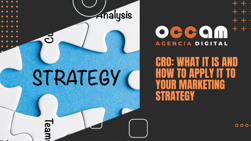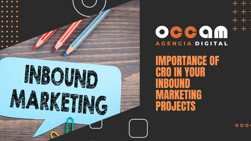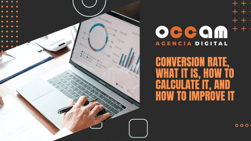Index Content
When we develop a website for our brand, it is essential to do so based on previously set objectives. Attracting visitors to our site is a fundamental step in our strategy, however, if those visitors do not convert into potential customers, our efforts will have been in vain .
A high volume of visitors to your website does not necessarily translate into an increase in the level of business. Only active visitors, who fill out a form or add items to their basket, influence the profits generated by the website. This is called conversions and in this article we will talk about how to optimise and analyse them to improve your online marketing strategy .
Conversion Rate Optimisation (CRO)
When we measure the success of a website in economic terms, the important thing is the number of users reached. However, while a website that has 3,000 visits per month seems to promise a higher level of sales, another website with 300 visits may be able to better incite a purchase.
According to IONOS, conversion rate optimisation (CRO) deals with the observation, analysis and improvement of the conversion rate, being one of the most important sub-disciplines of marketing and constituting one of the key performance indicators (KPI's)
This indicator helps us to quantify the success of a website, especially if it is dedicated to online commerce. Optimising conversion means increasing sales through the adaptation of various elements such as usability, design or web content .
Although advertising is still very valuable as a source of revenue, today it plays a secondary role. Part of the current web offer is linked to commercial interests that focus on the sale of goods and services or the subscription to newsletters by their users, and it has become a more important part.
The conversion rate is expressed in percentages and is calculated with the following formula:
Conversion rate (%) = Number of conversions*100 / Number of visits to the website
how to improve your conversion rate?
Improving your conversion rate brings with it many advantages, the main one being to get potential customers to take a specific action when they enter the site. But according to Iebs School, this is not the only advantage:
> Improving your conversion rate helps you gain new customers
> It can help you reduce your CAC (Customer Acquisition Cost) and increase your ROI (Return on Investment)
>Finally, it is beneficial in attracting links to your website
The steps to follow to improve the conversion of a website will depend on the nature of the site. In any case, there are different aspects that determine it and it must be taken into account that the actions that the user performs will be influenced by the characteristics of the website itself, its usability and the elements that make it up. Some of the most important are the following.
Whether it is a news portal or an online shop, usability is one of the most important factors to take into account, as it directly affects the user experience on your website.
The structure that makes up a website and the elements it includes must be aimed at optimising the conversion rate, so it is important to detect the weak points of your website and how you can improve it.
On the one hand, you should make sure that the navigation menu includes all the sections and topics of the website and that the links between them work effectively. In addition, you should check that all the buttons you make available to visitors, as well as the forms they can fill in, fulfil their function or lead to the desired place.
On theother hand, make sure that the texts you include on your website are legible for all users, taking into account the type of font, its size and the language and tone used; always bearing in mind your buyer persona.
A user-oriented design can be key when it comes to attracting new customers. Your website is your letter of introduction. Think that for many users it may be the first thing they know about your brand, so its layout and design cannot fall into oblivion .
The colours used, the layout of the elements, etc. affect, believe it or not, the purchasing decisions of your future customers. An efficient design aimed at facilitating the user experience can help them to find what they are looking for easily and to complete an action without leaving the website. You must avoid the appearance and composition of your site leading the visitor to feel frustrated for not finding what they are looking for.
In addition, when designing your website you must take into account the different devices that we use today. The design must be responsive, that is, its appearance must be adjusted to different devices. The user must have a pleasant experience whether they access the site from their laptop, mobile phone or tablet.
If your website is dedicated to e-commerce, your ultimate goal is the purchase of goods and services by your website visitors. In this case, according to IONOS, the moment of entering a product in the shopping basket is decisive. If you find that very few users perform this action, this may be due to the fact that it is too complicated for the user, the lack of payment methods or a problem of lack of trust. IONOS proposes the following measures for action in this regard:
-
- Integrate elements of trust (Trusted Shops): here you can offer effective customer service, expand payment options or include customer reviews with product photos.
- Simplify the purchasing process: for example, by including the option of purchasing without prior registration.
- Include a reminder for the user in case items remain in the basket for a period of time without a purchase being made.
Your presence on the internet and on social networks is essential to improve the image that users have of you and, of course, will help you gain notoriety. It is important that they see that you are present .
Make sure you stay active by posting relevant content on all platforms, answer any questions and comments and take care of the way you communicate.
Keep in mind that the content you publish must be of high quality, to meet the expectations of your users. Combine text, photos and videos and include calls to action in strategic places.
IONOS recommends the implementation of personalised content, such as product suggestions or articles, as well as video tutorials explaining how to perform specific actions on the website.
Finally, the correct use of keywords and the use of headings, listings and bold can make the content you publish much more successful.
Finally, you must take into account that each user is different and that the ways of navigation vary from one to another, it is important that you check which methods work and which do not and that you adapt to the needs of the users who visit your website. Listening to your users and making improvements based on them will improve your investment rate.
Conversion optimisation is a process of continuous improvement that will provide you with better results, so we hope this post has helped you to get ideas on how to improve it. We look forward to seeing you in the next one!





